The First National Art Museum Opened in 1793 This Museum Still in Operation Today Is
| Muséum national d'histoire naturelle | |
 Grand Gallery of Evolution of the National Museum of Natural History | |
| Location within Paris | |
| Established | June ten, 1793 (1793-06-10) |
|---|---|
| Location | 57 Rue Cuvier, Paris, France |
| Coordinates | Coordinates: 48°fifty′32″Due north 2°21′23″E / 48.842109°N 2.356286°E / 48.842109; 2.356286 |
| Type | natural history museum |
| Drove size | 67 meg specimens[1] |
| Visitors | one.9 one thousand thousand per year |
| Manager | Gilles Bœuf |
| Public transit access | Jussieu Place Monge Austerlitz |
| Website | www |
| Muséum national d'histoire naturelle network | |
| |
The French National Museum of Natural History, known in French equally the Muséum national d'histoire naturelle (abbreviation MNHN), is the national natural history museum of France and a thousand établissement of higher education office of Sorbonne Universities. The main museum, with 4 galleries, is located in Paris, France, within the Jardin des Plantes on the left banking concern of the River Seine. It was formally founded in 1793 during the French Revolution, but was begun even before in 1635 as the royal garden of medicinal plants. The museum now has fourteen sites throughout French republic.
History [edit]
17th-18th century [edit]
-
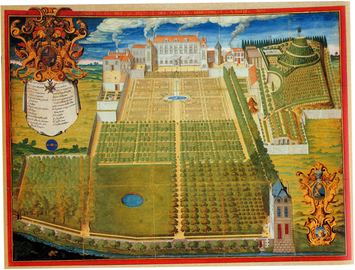
The Royal Garden of Medicinal Plants in 1636
-

-

Buffon'due south "Natural History" (1763)
-

The Museum's seal, designed in 1793, illustrates the three realms of Nature, Collective piece of work, and the French Revolution.
The museum was formally established on June ten, 1793, by the French Convention, the government during the French Revolution, at the aforementioned time that it established the Louvre Museum.[ii] But its origins went back much further, to the Royal Garden of Medicinal Plants, which was created by Rex Louis Xiii in 1635, and was directed and run by the royal physicians. A royal proclamation of the male child-king Louis 15 on 31 March 1718, removed the purely medical function. Too growing and studying plants useful for health, the purple garden offered public lectures on phytology, chemistry, and comparative anatomy. In 1729 the chateau in the garden was enlarged with an upper floor, and transformed into the cabinet of natural history, designed for the majestic collections of zoology and mineralogy. A serial of greenhouses were constructed on the westward side of the garden, to study the plants and animals nerveless by French explorers for their for medical and commercial uses.[three]
From 1739 until 1788, the garden was nether the direction of Georges-Louis Leclerc, Comte de Buffon, one of the leading naturalists of the Enlightenment. Though he did not go on scientific expeditions himself, he wrote a monumental and influential piece of work, "Natural History", in 30-vi volumes, published betwixt 1749 and 1788. In his books, he challenged the traditional religious ideas that nature had not inverse since the creation; he suggested that the world was seventy-five thousand years former, divided into seven periods, with man arriving in the most recent. He also helped fund much enquiry, through the iron foundry which he endemic and directed. His statue is prominently placed in front of the Gallery of Evolution.[4]
Following the French Revolution the museum was reorganized, with twelve professorships of equal rank. Some of its early on professors included eminent comparative anatomist Georges Cuvier and the pioneers of the theory of evolution. Jean-Baptiste de Lamarck and Étienne Geoffroy Saint-Hilaire. The museum's aims were to instruct the public, put together collections and conduct scientific research. The naturalist Louis Jean Marie Daubenton wrote extensively about biology for the pioneer French Encyclopédie, and gave his name to several newly-discovered species. The museum sent its trained botanists on scientific expeditions around the world. Major figures in the museum included Déodat de Dolomieu, who gave his proper noun to the mineral dolomite and to a volcano on Reunion island, and the botanist Rene Desfontaines, who spent two years collecting plants for written report Tunisia and Algeria, and whose book "Flora Atlantica" (1798–1799, 2 vols), added three hundred genera new to scientific discipline.[5]
When Napoleon Bonaparte launched his military campaign Arab republic of egypt in 1798, his army was accompanied by a 154 scientists, including botanists, chemists, mineralogists, including Étienne Geoffroy Saint-Hilaire, Vivant Denon, Joseph Fourier, and Claude Louis Berthollet, who together took back a big quantity of specimens and illustrations to enrich the collections of the museum.[vi]
19th century [edit]
-

Programme of the Jardin des Plantes and its buildings in 1820
The museum connected to flourish during the 19th century, particularly under the direction of chemist Michel Eugène Chevreul, His enquiry with animal fats [7] revolutionized the industry of soap and of candles and led to his isolation of the heptadecanoic (margaric), stearic, and oleic fat acids. In the medical field, he was first to demonstrate that diabetics excrete glucose.[8] and to isolate creatine.[nine] His theories of color "provided the scientific basis for Impressionist and Neo-Impressionist painting."[10]
Henri Becquerel held the chair for Applied Physics at the Muséum (1892–1908). By wrapping uranium salts in photographic paper, he commencement demonstrated the radioactive properties of uranium. In 1903, he shared the Nobel Prize in Physics with Pierre Curie and Marie Curie for the discovery of spontaneous radioactive decay.[11] Four generations of Becquerels held this chairmanship, from 1838 to 1948.[12]
As its collections grew, the museum was enlarged, with the structure of a new gallery of zoology. it was begun in 1877 and completed in 1889, for the 100th ceremony of the French Revolution. A new gallery of paleontology and comparative anatomy was opened in 1897. The cost of construction Drained the museum budget and it began to run short of funds. Its emphasis on didactics brought it into disharmonize with the University of Paris, which had better political connections. It gradually scaled back its plan of teaching and focused primarily on inquiry and the museum collections.[13]
20th-21st century [edit]
Afterwards receiving greater financial autonomy in 1907, it began a new stage of growth. In 1934, the Museum opened the Paris Zoological Park, a new zoo to in the Bois de Vincennes, equally the habitation for the larger animals of the Menagerie of the Jardin des Plantes. In 1937 information technology opens the Musée de l'Homme, a museum of anthropology located in Palais de Chaillot, across the Seine from the Eiffel Tower, in a building created for the 1937 Paris International Exposition. In recent decades, it has directed its research and educational activity efforts at the effects on the surroundings of human exploitation. In French public assistants, the Muséum is classed as a chiliad établissement of college education.
Some of the buildings, peculiarly the Thousand Gallery of Development, completed in 1889, were in poor condition by the mid-20th century. It was closed entirely in 1965, and so underwent major restoration between 1991 and 1994 to its present state.[xiv]
Plan [edit]

Galleries and gardens [edit]
The birthplace of the museum and a large office of its modern collections are institute in v galleries in the Jardin des Plantes. These are the Gallery of Evolution; the Gallery of Mineralogy and Geology; the Gallery of Botany; the Gallery of Paleontology and Comparative Anatomy and the Laboratory of Entomology.[15]
The Grand Gallery of Evolution [edit]
-

Garden facade of the Grand Gallery of Evolution
-

Interior of the Grand Gallery of Evolution
-

Parade of African mammals
-
A stuffed disguised vulture (Gypaetus barbatus)
-

A plastified behemothic squid, nine meters long, in the Gallery of Evolution
The National Museum of Natural History has been called "the Louvre of the Natural Sciences."[16] Its largest and best-known gallery is the Grand Gallery of Evolution, located at the end of the cardinal alley facing the formal garden. It replaced an earlier Neoclassical gallery built next to the same by Buffon, opened in 1785, and demolished in 1935. It was proposed in 1872 and begun in 1877 by the builder Louis-Jules André, a teacher at the influential École des Beaux-Arts in Paris. It is a prominent instance of Beaux Arts Architecture. It was opened in 1889 for the Paris Universal Exposition of 1889, which as well presented the Eiffel Tower. It was never fully completed in its original design; it never received the neoclassical entrance planned for the side of the edifice away from the garden, facing Rue Geoffroy-Saint-Hilaire.[17]
The facade of the building was designed specifically as a backdrop for the garden. The facade facing the garden is divided into eleven traverses. Ten are decorated with sculpted medallions honouring prominent French scientists associated with the museum. The central traverse has a larger marble statue of a woman seated holding a book, in a pose similar to that of statue of Buffon facing the edifice. The statues are the work of Eugene Guillaume, a pupil of the sculptor Pradier.
While the building exterior was neo-classical, the atomic number 26 framework of the interior was extremely modern for the 19th century, like that of the Gare d'Orsay railroad station of the same catamenia. It contained an immense rectangular hall, 55 meters long, 25 wide and fifteen meters high, supported by forty slender cast-iron columns, and was originally covered with a glass roof one m square meters in size.The building suffered from technical problems, and was closed entirely in 1965. Information technology was extensively remodelled betwixt 1991–94 and reopened in its present course.[xviii]
The great central hall, kept in its same class but enlarged during the modernisation, is devoted to the presentation of marine animals on the lower sides, and, on a platform in the center, a parade of full-size African mammals, including a rhinoceros originally presented to Male monarch Louis Xv in the 18th century. On the garden side is another hall, in its original size, devoted to animals which have disappeared or are in danger of extinction.[nineteen]
Gallery of Mineralogy and Geology [edit]
-

Gallery of Mineralogy and Geology
-

Native gold and quartz from California
-

-

The Gallery of Mineralogy, looking beyond the formal garden and close to the Gallery of Development, was constructed between 1833 and 1837 by Charles Rohault de Fleury in a neoclassical mode, with two porticos of Doric columns. Straight in forepart is the rose garden, renewed in 1990 with 170 types of European roses, every bit well as a Styphnolobium japonicum or Japanese pagoda tree, planted in that location by Bernard de Jussieu in 1747.[20]
The gallery contains over 600,000 stones and fossils. It is particularly known for its drove of giant crystals, including colourful examples of azurite, Tourmaline (Rubelite), Malachite and Ammonite. Other displays include the jars and vestiges of the original royal apothecary of Louis 14, and three Florentine marble marquetry tables from the palace of Cardinal Mazarin.[21]
The gallery also contains a large collection of meteorites, gathered from around the globe. These include a large fragment of Canyon Diablo meteorite, a piece of an asteroid which fell in Arizona about 550,000 years ago, and created the Meteor crater. It weighs 360 kilograms (970 pounds).[22]
Gallery of Botany [edit]
-

The Gallery of Botany. At left is the Robinia pseudoacacia, one of the oldest two trees in Paris, planted in 1635 by Vespasien Robin
-
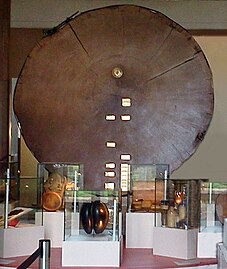
Slice of a behemothic Sequoia tree in the Gallery of Botany
-

Specimen of Nepenthes mirabilis, (tropical pitcher plant) from Southeast Asia, one of 7.five million plants in the Herbier National
The Gallery of Botany is on the Allée the Buffon facing the eye of the garden, between the Gallery of Mineralogy and the Gallery of Paleontology. At the corner is one of the two oldest trees in Paris, a Robinia pseudoacacia or black locust, planted in 1635 by Vespasien Robin, the majestic gardener and botanist, from an earlier tree brought from America by his brother, also a botanist, in 1601. It is tied in age with another from the same source planted at the same time on the foursquare of Saint-Julien-le-Pauvre.[23]
The Gallery was built in 1930-35 with a grant from the Rockefeller Foundation. Directly in forepart is a statue entitled "Scientific discipline and Mystery" by J.L.D. Schroeder, made in 1889. It represents the enigma of and erstwhile man meditating over an egg and a chicken, pondering which came first.[24]
The master content of the gallery is the Herbier National, a drove representing vii.v million plants collected since the founding of the muuseum. They are divided for written report into Spermatophytes, plants which reproduce with seeds, and cryptogams, plants which reproduce with spores, such every bit algae, lichens and mushrooms. Many of the plants were nerveless by Jean Baptiste Christophore Fusée Aublet, the purple pharmacist and botanist in French Guiana. In 1775 he published his "Histoire des plantes de la Guiane Française" describing 576 genera and ane,241 species of neotropical plants, including more than than 400 species that were new to scientific discipline, at a time when just twenty,000 plants had been described,[25]
The ground floor interior of the gallery has vestibules built in a combination of Fine art Deco and Neo-Egyptian styles. It is used for temporary exhibits.[26] The exhibits include a slice of a giant Sequoia tree, 2200 years old, which cruel naturally in 1917.
The Gallery of Paleontology and Comparative Anatomy [edit]
-

Facade of the Gallery of Paleontology and Comparative Anatomy
-
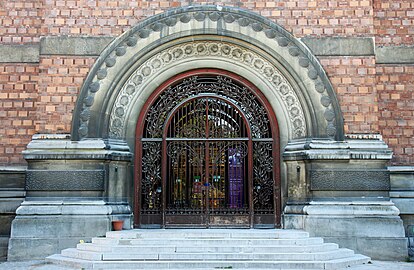
Relief sculpture and ironwork on the archway of the gallery
-

Dinosaur gallery
-

-

The Gallery of Paleontology and Comparative Beefcake was congenital between 1894 and 1897 past builder Ferdinand Dutert, who had built the innovative iron-framed Galerie des machines at the 1889 Paris Exposition. A new pavilion in the same style was added to the west side of the gallery; it was completed in 1961. In front of the Gallery is the Iris Garden, created in 1964, which displays 260 varieties of iris flowers, and a sculpture, "Nymph with a pitcher" (1837) past Isidore Hippolyte Brion. The sides of gallery are also decorated with sculpture; twelve relief sculptures of animals in bronze and fourteen medallions of famous biologists. The ironwork grill and stone arches over the archway are filled with elaborate designs and sculpture of seashells. Inside the entrance is a big marble statue of an Orangutan strangling a hunter, created in 1885 past the noted beast sculptor Emmanuel Fremiet, best known for his statue of Joan of Arc on horseback on the Place des Pyramides in Paris.[27]
Jardin des Plantes [edit]
The Jardin des plantes is the home of the main galleries of the National Museum of Natural History, and a division of the Museum, which was born there. The garden was founded by Louis XIII 1635 as the Purple Garden of medicinal plants, under the management of the royal physician. In the early 18th century, the chateau of the gardens was enlarged to firm the collections of the royal chemist. In 1729, this collection was broadened into the Cabinet of Natural History, destined to receive the Imperial collections defended to zoology and mineralogy. New plants and animal species were nerveless from around the world, examined, illustrated, classified, named and described in publications which were circulated beyond Europe and to America. [28] An amphitheater was constructed in the garden in 1787 to provide a venue for lectures and classes on the new discoveries. New greenhouses were congenital outset in 1788, and the size of the gardens was doubled. The gardens served as the laboratory of scientists including Jean Baptiste Lamarck, author of the earliest theory of evolution, and were a base for major scientific expeditions past Nicolas Baudin, Alexander von Humboldt, Jules Dumont d'Urville and others throughout the 18th and 19th century.[29]
The gardens today include a large formal garden planted in geometric designs; and two enormous greenhouses, keeping tropical plants at a steady temperature of 22 degrees celsius. The Alpine gardens present plants coming from Corsica, the Caucasus, North American and the Himalaya. The gardens of the School of Botany contain 3,800 species of plants, displayed by genre and family unit.[30]
Ménagerie of the Jardin des Plantes [edit]
-
The Rotunda of the Menagerie
-

-
The Menagerie is the 2nd-oldest public zoo in the earth still in operation, following the Tiergarten Schönbrunn in Vienna, Republic of austria, founded in 1752.[31] It occupies the northeast side of the garden forth the Quai St. Bernard, roofing v hectares (thirteen.six acres). It was created between 1798 and 1836 as a dwelling for the animals of the regal menagerie at Versailles, which were largely abandoned subsequently the French Revolution. Its architecture features picturesque "fabriques", or pavilions, mostly created in the 19th century, to shelter the animals. In the 20th century the larger animals were moved to the Paris Zoological Park, a more all-encompassing site in the Bois de Vincennes. also governed by the National Museum of Natural History. The menagerie is currently domicile to about half dozen hundred mammals, birds, reptiles, amphibians and invertebrates, representing most 189 species.[32] These include the Amur leopard from China, one of the rarest cats on earth.
Mission and system [edit]
The museum has as its mission both enquiry (fundamental and applied) and public improvidence of knowledge. Information technology is organized into seven research and three improvidence departments.[33]
The enquiry departments are:
- Classification and Evolution
- Regulation, Development, and Molecular Diversity
- Aquatic Environments and Populations
- Ecology and Biodiversity Management
- History of Earth
- Men, Nature, and Societies, and
- Prehistory
The diffusion departments are:
- The Galleries of the Jardin des Plantes
- Botanical Parks and Zoos, and
- The Museum of Man ( Musée de l'Homme )
The museum also developed college didactics, and now delivers a principal's degree.[34]

Main façade of the Gallery of Palaeontology and Comparative Anatomy.
Location and branches [edit]
The museum comprises 14 sites[35] throughout France with iv in Paris, including the Jardin des Plantes in the fifth arrondissement. (métro Identify Monge).
The herbarium of the museum, referred to by code P, includes a large number of of import collections amongst its 8 000 000 plant specimens. The historical collections incorporated into the herbarium, each with its P prefix, include those of Jean-Baptiste de Lamarck (P-LA) René Louiche Desfontaines (P-Desf.), Joseph Pitton de Tournefort and Charles Plumier (P-TRF). The designation at CITES is FR 75A. Information technology publishes the botanical journal Adansonia and journals on the flora of New Caledonia, Madagascar and Comoro Islands, Cambodia, Laos and Vietnam, Cameroon, and Gabon.[36]
The Musée de 50'Homme is also in Paris, in the 16th arrondissement (métro Trocadéro). It houses displays in ethnography and physical anthropology, including artifacts, fossils, and other objects.

Also part of the museum are:
- Three zoos, the Paris Zoological Park ( Parc zoologique de Paris , as well known as the Zoo de Vincennes ), at the Bois de Vincennes in the twelfth arrondissement, the Cleres Zoological Park ( Parc zoologique de Clères ), at a medieval estate in Clères (Seine-Maritime) and the Réserve de la Haute Touche in Obterre (Indre), the largest in France,
- Three botanical parks, the Arboretum de Chèvreloup in Rocquencourt next to the Château de Versailles , the Jardin botanique exotique de Menton and the Jardin alpin de La Jaÿsinia in Samoëns,
- Two museums, the Musée de fifty'abri Pataud in Les Eyzies-de-Tayac and the Harmas de Fabre in Sérignan-du-Comtat,
- Four scientific sites, the Institut de Paléontologie humaine in Paris, the Centre d'Écologie générale de Brunoy , the Station de Biologie marine et Marinarium de Concarneau and the CRESCO (Centre de Recherche et d'Enseignement sur les Systèmes Côtiers) in Dinard.
Chairs [edit]

The transformation of the Jardin from the medicinal garden of the King to a national public museum of natural history required the creation of twelve chaired positions. Over the ensuing years the number of Chairs and their subject areas evolved, some being subdivided into two positions and others removed. The list of Chairs of the Muséum national d'histoire naturelle includes major figures in the history of the Natural sciences. Early on chaired positions were held past Jean-Baptiste Lamarck, René Desfontaines and Georges Cuvier, and later occupied by Paul Rivet, Léon Vaillant and others.
In popular culture [edit]
The Gallery of Palaeontology and Comparative Beefcake and other parts of Jardin des Plantes was a source of inspiration for French graphic novelist Jacques Tardi. The gallery appears on the get-go page and several subsequent pages of Adèle et la bête (Adèle and the Beast; 1976), the first album in the series of Les Aventures extraordinaires d'Adèle Blanc-Sec . The story opens with a 136-meg-year-old pterodactyl egg hatching, and a live pterodactyl escaping through the gallery glass roof, wreaking havoc and killing people in Paris. (The Gallery of Palaeontology and Comparative Beefcake returned the favor past placing a life size paper-thin cutout of Adèle and the hatching pterodactyl in a drinking glass chiffonier exterior the chief entrance on the pinnacle flooring balustrade.)
Directors of the Museum [edit]
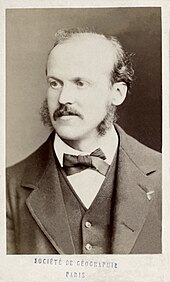
Directors elected for 1 year:
- 1793 to 1794 : Louis Jean-Marie Daubenton
- 1794 to 1795 : Antoine-Laurent de Jussieu
- 1795 to 1796 : Bernard Germain Étienne de Laville-sur-Illon, comte de Lacépède
- 1796 to 1797 : Louis Jean-Marie Daubenton
- 1797 to 1798 : Louis Jean-Marie Daubenton
- 1798 to 1799 : Antoine-Laurent de Jussieu
- 1799 to 1800 : Antoine-Laurent de Jussieu
Directors elected for two years:
- 1800 to 1801 : Antoine-François Fourcroy
- 1802 to 1803 : René Desfontaines
- 1804 to 1805 : Antoine-François Fourcroy
- 1806 to 1807 : René Desfontaines
- 1808 to 1809 : Georges Cuvier
- 1810 to 1811 : René Desfontaines
- 1812 to 1813 : André Laugier
- 1814 to 1815 : André Thouin
- 1816 to 1817 : André Thouin
- 1818 to 1819 : André Laugier
- 1820 to 1821 : René Desfontaines
- 1822 to 1823 : Georges Cuvier
- 1824 to 1825 : Louis Cordier
- 1826 to 1827 : Georges Cuvier
- 1828 to 1829 : René Desfontaines
- 1830 to 1831 : Georges Cuvier
- 1832 to 1833 : Louis Cordier
- 1834 to 1835 : Adrien de Jussieu
- 1836 to 1837 : Michel Eugène Chevreul[37]
- 1838 to 1839 : Louis Cordier
- 1840 to 1841 : Michel Eugène Chevreul
- 1842 to 1843 : Adrien de Jussieu
- 1844 to 1845 : Michel Eugène Chevreul
- 1846 to 1847 : Adolphe Brongniart
- 1848 to 1849 : Adrien de Jussieu
- 1850 to 1851 : Michel Eugène Chevreul
- 1852 to 1853 : André Marie Constant Duméril
- 1854 to 1855 : Michel Eugène Chevreul
- 1856 to 1857 : Marie Jean Pierre Flourens
- 1858 to 1859 : Michel Eugène Chevreul
- 1860 to 1861 : Isidore Geoffroy Saint-Hilaire
- 1862 to 1863 : Michel Eugène Chevreul
Directors elected for v years:
- 1863 to 1879 : Michel Eugène Chevreul
- 1879 to 1891 : Edmond Frémy
- 1891 to 1900 : Alphonse Milne-Edwards
- 1900 to 1919 : Edmond Perrier
- 1919 to 1931 : Louis Mangin
- 1932 to 1936 : Paul Lemoine
- 1936 to 1942 : Louis Germain
- 1942 to 1949 : Achille Urbain
- 1950 to 1950 : René Jeannel
- 1951 to 1965 : Roger Heim
- 1966 to 1970 : Maurice Fontaine
- 1971 to 1975 : Yves Le Grand
- 1976 to 1985 : Jean Dorst
- 1985 to 1990 : Philippe Taquet
- 1994 to 1999 : Henry de Lumley
Presidents elected for five years:
- 2002 to 2006 : Bernard Chevassus-au-Louis
- 2006 to 2008 : André Menez (deceased in February 2008)
- 2008 to ... : Gilles Boeuf
Friends [edit]
The Friends of the Natural History Museum Paris is a private arrangement that provides financial support for the museum, its branches and the Jardin des Plantes . Membership includes gratuitous entry to all galleries of the Museum and the botanical garden. The Friends have assisted the museum with many purchases for its collections over the years, as well as funds for scientific and structural development.
Run into also [edit]
- List of museums in Paris
Notes and citations [edit]
- ^ "BILAN DU PREMIER RECOLEMENT DECENNAL DES MUSEES DE French republic" (PDF). www.mnhn.fr. 10 Oct 2014.
- ^ Deligeorges, Gady and Labalette, "Le Jardin des Plantes et le Muséum national de'histoire naturalle" (2004, p.fourteen
- ^ Deligeorges, Gady and Labalette, "Le Jardin des Plantes et le Muséum national de'histoire naturelle" (2004), p. 4-5
- ^ Deligeorges, Gady and Labalette, "Le Jardin des Plantes et le Muséum national de'histoire naturelle" (2004), p. 10
- ^ Deligeorges, Gady and Labalette, "Le Jardin des Plantes et le Muséum national de'histoire naturelle" (2004), p. 9
- ^ Deligeorges, Gady and Labalette, "Le Jardin des Plantes et le Muséum national de'histoire naturelle" (2004), p. xv
- ^ Chevreul, M.E., Recherches sur les corps gras d'origine animale, F.G. Levrault, Paris, 1823
- ^ Chevreul, M.Due east. Note sur le Sucre de Diabetes, Annales de Chemie, Paris 1815
- ^ "An Introduction to Creatine". 2016-11-23.
- ^ Itten, Johannes, The Art of Color, New York, 1961
- ^ Henri Becquerel – Biographical Nobelprize.org.
- ^ A. Allisy (Nov 1, 1996). "Henri Becquerel: The Discovery of Radioactivity". Radiation Protection Dosimetry. 68 (1): 3–10. doi:10.1093/oxfordjournals.rpd.a031848.
- ^ Deligeorges, Gady and Labalette, "Le Jardin des Plantes et le Muséum national de'histoire naturelle" (2004), p. 20-22
- ^ Deligeorges, Gady and Labalette, "Le Jardin des Plantes et le Muséum national de'histoire naturelle" (2004), p. twenty-22
- ^ Deligeorges, Gady, Labalette, "Le Jardin des Plantes et le Museum National d'Histoire Naturelle" (2004), p. 38
- ^ Deligeorges, Gady, Labalette, "Le Jardin des Plantes et le Museum National d'Histoire Naturelle" (2004), p. 38
- ^ Deligeorges, Gady, Labalette, "Le Jardin des Plantes et le Museum National d'Histoire Naturelle" (2004), p. 38
- ^ Deligeorges, Gady, Labalette, "Le Jardin des Plantes et le Museum National d'Histoire Naturelle" (2004), p. 39
- ^ Deligeorges, Gady, Labalette, "Le Jardin des Plantes et le Museum National d'Histoire Naturelle" (2004), p. forty-41
- ^ Deligeorges, Gady, Labalette, "Le Jardin des Plantes et le Museum National d'Histoire Naturelle" (2004), p. 42
- ^ Deligeorges, Gady, Labalette, "Le Jardin des Plantes et le Museum National d'Histoire Naturelle" (2004), p. 42-43
- ^ [ane] site of the Jardin des Plantes- Gallery of Geology and Mineralogy
- ^ Deligeorges, Gady, Labalette, "Le Jardin des Plantes et le Museum National d'Histoire Naturelle" (2004), p. 42
- ^ Deligeorges, Gady and Labalette (2004), p. 44
- ^ Mori, Scott A. "Jean Baptiste Christophe Fusée Aublet (1720-1778)". NYBG. New York Botanic Garden.
- ^ Deligeorges, Gady and Labalette (2004), p. 44
- ^ Deligeorges, Gady and Labalette (2004), p. 45
- ^ Deligeorges, Gady and Labalette (2004), p. four-5
- ^ Deligeorges, Gady and Labalette (2004), p. 28-29
- ^ Deligeorges, Gady and Labalette (2004), p. 28-29
- ^ [2] Site of the Jardin des Plantes (in English)
- ^ Deligeorges, Gady, Labalette, "Le Jardin des Plantes et le Museum National d'Histoire Naturelle" (2004), p. 58
- ^ Muséum national d'histoire naturelle; official website
- ^ Official website
- ^ Implantations, site of the MNHN
- ^ Holmgren, P. K.; North. H. Holmgren. (2008). "Muséum National d'Histoire Naturelle". Index Herbariorum. The New York Botanical Garden. Retrieved 2009-03-10 .
- ^ Night at.
Bibliography (in French) [edit]
- Deligeorges, Stephane; Gady, Alexandre; Labalette, Françoise (2004). Le Jardin des plantes et le Muséum national d'histoire naturelle (in French). Éditions du Patrimoine- Center des Monuments Nationaux. ISBN978-ii-85822-601-6.
External links [edit]
- MNHN official website (English version)
- the Virtual Gallery of Mineralogy (English version)
- Flickr By and large Paris, some Lille.
- Photos of Muséum national d'histoire naturelle (English version)
Source: https://en.wikipedia.org/wiki/National_Museum_of_Natural_History,_France



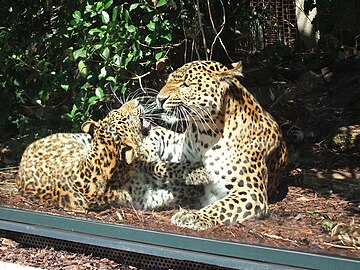
0 Response to "The First National Art Museum Opened in 1793 This Museum Still in Operation Today Is"
Post a Comment